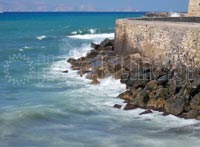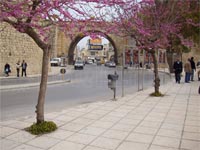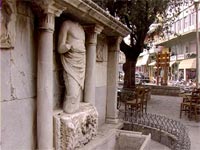 HERAKLION OF CRETE - TOUR
Koules
HERAKLION OF CRETE - TOUR
Koules
The Venetian marine fort, at the entrance of the harbor, was made for the control and for the protection of the area. The Rocca a mare, as it was called then, was built between 1523 and 1540.
It is a solid building with 26 rooms on the ground floor, which were developed along a central corridor. During the Turkish occupation, these areas were converted into prisons.

At the second level there are loopholes and spots for cannons. Approaching the fort, the marble reliefs are visible, depicting the winged lions, which is the symbol of Venetian domination.
The locals usually take a walk, run or bike up to the edge of the wharf, at Faro, where the distance is 2.5 km
Navigating the Venetian Walls
It all began in 1462. The best engineer of Venice, Michele Sanmicheli, made designs and of more than 100 years of work by the Cretans, was built this imposing wall, 3 kilometers long with four gates and 7 bastions.
The attacks against the fort were numerous, with the biggest one that of 21 years that ended only with the Turk’s gold (1648 - 1669). The wall never fell and did not have signs of bloody wars. This is the most beautiful walk around Heraklion, with breathtaking views, green and benches for rest.
The best way to start the tour is from the bastion of St. Andrew, on the road of Ethnarchou Makarios. From here, as from the bastion of Sampionara (or Ammos) on the eastern edge of the fortification, it was done the raid and occupation of the Kastro from the Turks in 1669. Furthermore, in the northern rampart is the best balcony of Heraklion, overlooking the Cretan Sea.

Walking to the city center, you will meet the second outpost of the Pantokratoras, and then, above Chanioporta, is the bastion of Bethlehem, which took its name from the small church of Our Lady of Bethlehem which was on the outside.
The next bastion is the Martinengo, shortly after the Mesea Porta, next to the street of Plastiras. Along with that of the Almighty and of Vitouri were the strongest terrestrial bastions. Above the rampart is the tomb of Kazantzakis. It is the southernmost and highest point of the fortification from where is shown the full picture of the city.
Crossing the parking of the stadium, there is the Kenoyria Porta, the bastion of Jesus. From this point onwards, the surrounding area has been formed, while the walls become "shorter" and the tall buildings prevent the view. Continuing on the dirt road and after the bastion Vitouri, the walk ends up to Square of Freedom.
The total distance from the bastion of San Andreas is 2.5 km. There are exits from the walls in each bastion. In the first four, there are notes with details of their construction. At several points in the trench of the walls, recreational spaces have been created, with basketball or tennis yards, green areas with benches and small walking trails.
The Fountains of Heraklion

Apart from the Fountain of Morosini with the four lions, there are two other fountains. The first is the fountain of Mebo of 1588, located at the square of Kornaros, right there that the Old Market (Street 1866) ends up. It is decorated with Venetian coats of arms and a headless statue of the Roman period. Behind it there is a sculpture that depicts the Erotokritos and Aretousa, the heroes of the famous lyric poem of the Cretan Renaissance.
The second most famous fountain is Priuli or Ntelimarkou, built in 1666, by Antonio Priuli, the general predictor. It is located south of the gate of Dermata, in the neighborhood of the Agia Triada.